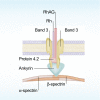Red cell membrane: past, present, and future
- PMID: 18988878
- PMCID: PMC2582001
- DOI: 10.1182/blood-2008-07-161166
Red cell membrane: past, present, and future
Abstract
As a result of natural selection driven by severe forms of malaria, 1 in 6 humans in the world, more than 1 billion people, are affected by red cell abnormalities, making them the most common of the inherited disorders. The non-nucleated red cell is unique among human cell type in that the plasma membrane, its only structural component, accounts for all of its diverse antigenic, transport, and mechanical characteristics. Our current concept of the red cell membrane envisions it as a composite structure in which a membrane envelope composed of cholesterol and phospholipids is secured to an elastic network of skeletal proteins via transmembrane proteins. Structural and functional characterization of the many constituents of the red cell membrane, in conjunction with biophysical and physiologic studies, has led to detailed description of the way in which the remarkable mechanical properties and other important characteristics of the red cells arise, and of the manner in which they fail in disease states. Current studies in this very active and exciting field are continuing to produce new and unexpected revelations on the function of the red cell membrane and thus of the cell in health and disease, and shed new light on membrane function in other diverse cell types.
Figures







References
-
- Van Leeuwenhoek A. Other microscopical observations made by the same, about the texture of the blood, the sap of some plants, the figures of sugar and salt, and the probable cause of the difference of their tastes. Philos Trans R Soc Lond. 1675;10:380–385.
-
- Bessis M, Delpech G. Discovery of the red blood cell with notes on priorities and credits of discoveries, past, present and future. Blood Cells. 1981;7:447–480. - PubMed
-
- Gulliver G. Medical Times and Gazette. London: John Churchill & Sons; 1862. Blood of Vertebrata.
-
- Singer SJ, Nicolson GL. The fluid mosaic model of the structure of cell membranes. Science. 1972;175:720–731. - PubMed
Publication types
MeSH terms
Substances
Grants and funding
LinkOut - more resources
Full Text Sources
Other Literature Sources
Medical
Research Materials
Miscellaneous

